カトレア図鑑
1.初めに
カトレヤは、洋ランの女王と呼ばれてきました。近縁属を含めた総称です。原種はカトレヤ属だけでは30数種と言われています。近縁属との交配種が作られてきました。
ここでは、カトレヤのグループの原種、大型の交配種、ミニカトレヤなどに分けて、主な種類、特徴、花の写真などを示します。
2009.8.8追記
従来から数個の亜属に分ける考えがありましたが、最近の遺伝子系統解析でもほぼ支持されています。
2 原種
(1)カトレヤの遺伝子系統解析
カトレヤ近縁属(Epidendrinae亜連)の遺伝子系統解析が行われています。Cattleyae(Cattleya、Laeliaなど)と、Epidendra(Epidendrumなど)に分けられます。ゲノム全体を対象にしたDNA多型解析法である、RAPD法(randomly amplifired polymorphic DNA)が用いられています。分子系統樹を下に示します。大まかには従来の形質による分類、4亜属と一致します。違いはluteora類はカトレヤ亜属内では遠縁で、kerriは遺伝子によっては特異な種類で、Intermedia節とGuttata節は単一系統でなく、それぞれ2系統が含まれていることです。
金国光、内藤俊栄、松井鋳一郎、園芸学雑誌、73(6)583-591 (2004)より
カトレヤ近縁、9属、15種(カッコ内の数字は花粉塊数)
カトレヤ属36種、40個体
Cattleya亜属、一葉
┌−−−−−−−−−−−−−−−C. quadricolor (Colombia)
┌ −└ −−−−−−−−−−−−−−−−−L. rex (Colombia)
│ ┌−−−−−−−−−−−−−−−C. gaskelliana var. alba (Colombia, Venezuela)
┌│ │ ┌ C. trianei 'Junio' (Colombia)
│ └−│ ┌ −−−−−└C. trianei var. amesiana 'Floriana' (Colombia)
│ │┌−−− └ −−−−−C. trianaei 'Dan' (Colombia)
│ └│ ┌ C. labiata var. amoena 'Fowleiana' (Brazil)
┌│ │ ┌└ C. percivaliana 'Summit' (Venezuela)
││ └┌ └−−C. schroederae 'C. Arango' x 'G. Misa's' (Colombia)
┌││ └ −−−−−−−−−−C. warneri (Brazil)
┌││└ −−−−− −−−−−C. mossiae (var. semialba x var. semialba 'Idem') (Venezuela)
││└ −−−−− −−−−− −−−−− C. jenmanii var. alba 'Fuchs Snow'(Venezuela)
││ ┌ −−−−−C. aurea 'Scully'sTipperary' (Colombia)
┌││ ┌ └−−−−−┌ C. warcewiczii var. semialba (Colombia, Brazil)
│ └ │ └ C. warcewiczii var. alba 'Leo Holgium' (Colombia, Brazil)
┌│ └−−−−− C. warcewiczii ('Low's x 'Sanderiana) (Colombia, Brazil)
│ │ (Stellata亜属)、花径小さい、側花弁幅狭い、唇弁特異
│ └−−−−−┌ C. luteora (Brazil, Peru, Equador, Bolivia)
┌│ └ C. iricolor
││ Rhizanthemum亜属、花を葉の退化したシュートに付ける
│ └ −−−−− −−−−−┌ C. walkeriana var Coerulea 'Azul Perfecta' (Brazil)
┌│ └ C. nobilior var. coerulea (Brazil)
││ C. kerrii、1-2茎、茎は細い、
│ └ −−−−− −−−−− −−−−−C. kerrii (Brazil)
│ Diphyllae亜属、シースは葉身を持たない、Intermedia節
│ ┌ C. intermedia var. aquinii 'Boa Vista' (Brazil)
┌−│ ┌ └ C. harrisoniana 'Shonan' (Brazil)
│ │ ┌ −└−−−−− C. forbesii var. alba (Brazil)
│ │ │Guttata節
│ │ ┌ −│ ┌ C. guttata 'Nakajima' (Brazil)
│ │ │ └−− −┌ −└ C. elongata (Brazil)
│ │ │ └−−┌ C. leopordii (Brazil)
│ │ │ └ C. amethystoglossa (Brazil)
│ │ │Intermedia節
│ └− │ ┌ −−−−− C. loddigesii (Brazil, Argentina)
−│ │ ┌ −−−−−└ −−−−−C. x dolosa var. alba (= C. loddigesii × C. walkeriana) (Brazil)
│ │ │ Acranthemum節
│ └ −│ ┌ C. aclandiae (Brazil)
│ │┌ −−−−−└ C. bicolor (Brazil)
│ └ │ Guttata節
│ └ −−−┌ −−−−−C. porphyroglossa (Brazil)
│ └ −−−−−┌ C. schilleriana 'Sanderiana' (Brazil)
│ └ C. violacea (Guyana-Peru, Venezuela,Brazil, Equador)
│ Skinneri亜属、多輪 Skinnneri節
│ ┌ C. skinneri 'Brumen Insel' (Guatemala - Panama)
└−−−−−−−−−−┌ −−−−− └C. x guatemalensis (skinneri x aurantiaca?) (Guatemala)
│ Aurantiaca節
└−−−−−┌ −−−−− C. aurantiaca 'Marigold' (Mexico, Guatemara, El Salvador, Honduras)
└−−−−┌ C. bowringiana var coerulea (Guatemara, Belize)
└ C. decker 'Brecht' (Guatemala - Panama, Colombia, Venezuela, Trinidad)
aragualensis, domaniana, dowiana, eldorado, luddemanniana, mendelii, mooreana,
(2)種類
グループに分けて、写真を示します
無名はorchid wikiより
Cattleya
−−−−−−−−−−Cattleya亜属−−−−−−−−−−
、一葉
C. quadricolor (Colombia)
(=chocoensis)
C. rex (Colombia)
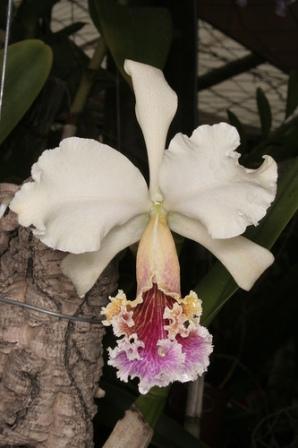
DescriptionPlant bloom from winter to spring with three to eight 17.5 cm wide flowers. Flowers are fragrant.
DistributionPlant is found growing on trees in the wet montane forest of Colombia and Peru at elevations of 1350 meters
CulturePlants should be grown in medium fir bark with partial to full sun. The plant is a intermediate to warm growing orchid species. Water approximately once a week. Plant can also be mounted.
NamingCommon Name: King of the Cattleyas
SynonymsCattleya labiata var rex [O'Brien]Schlechter ?
Retrieved from "http://orchids.wikia.com/wiki/Cattleya_rex"
−−−−−−−−−−
C. gaskelliana (Colombia, Venezuela)
wikip
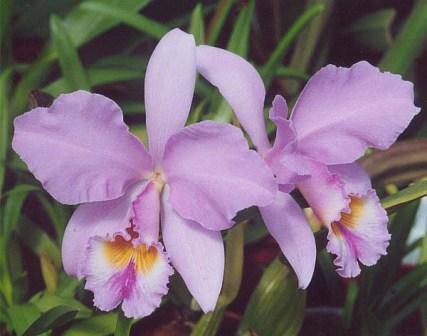
coerulea
yamada
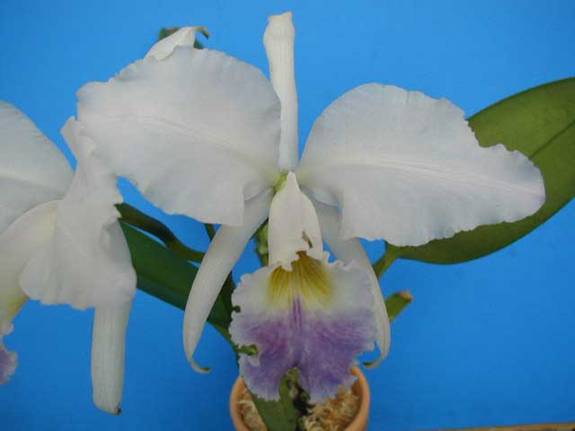
wikip
Binomial name
Cattleya gaskelliana
(N.E.Br.) Rchb.f. (1883)
Synonyms
Cattleya labiata var. gaskelliana N.E.Br. (1883)
C. gaskelliana var. alba (Colombia, Venezuela)
C. trianei (Colombia)
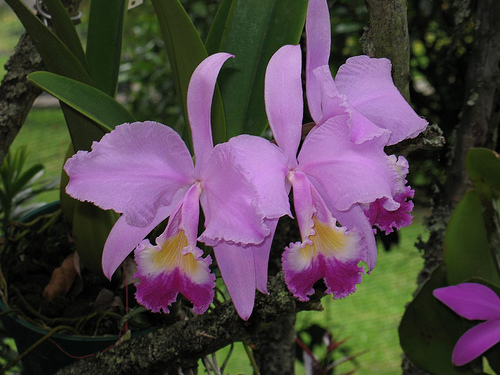
Description Plant blooms in the winter with three to fourteen 20 cm wide flowers. Flowers are fragrant.
It is the National flower of Colombia
DistributionPlant is found growing in Colombia
CulturePlants should be grown in medium fir bark with partial to full sun. The plant is a intermediate to warm growing orchid species. Water approximately once a week and reduce watering during the winter. Plant can also be mounted.
VaritiesImage Name Description
Cattleya trianae var albescens white petals and sepals, lip is white
Cattleya trianae var concolor white petals and sepals, lip is light pink
Cattleya trianae var. pincelata petals are pink with a patch of magenta and sepals light pink, lip is light pink with a yellow and magenta spot
Cattleya trianae variant light pink petals and sepals, lip is light pink with a yellow and magenta spot
NamingCommon Name:Dr. Triana's Cattleya
Retrieved from "http://orchids.wikia.com/wiki/Cattleya_trianae"
C. labiata (Brazil)

DistributionCattleya labiata is found in Brazil growing on trees in the moutain ranges from 500 meters and above
CulturePlants should be grown in medium fir bark with partial to full sun. Cattleya labiata is a cool to warm growing orchid species. Water approximately once a week.
VarietiesImage Name Description
Cattleya labiata var. semi alba
(L.C.Menezes 2002) White sepals and petals, white lip with a patch of pink and yellow
Cattleya labiata var.alba White sepals and petals, white lip with a patch of yellow
NamingCommon Name: Crimson Cattleya, Ruby Lipped Cattleya
C. percivaliana (Venezuela)
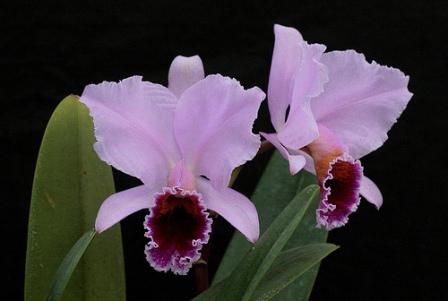
DescriptionPlant blooms in the summer to winter with two to four 12.5 cm flowers. Flowers have a musky and spicy scent.
DistributionPlants are found growing on trees and rocky slopes near water in Venezula from 1300 to 2000 meters in elevation.
CulturePlants should be grown in medium fir bark with partial to full sun. Cattleya percivaliana is a cool to warm growing orchid species. Water approximately once a week.
VaritiesImage Name Description
Cattleya percivaliana 'Remolache' Sepals are white with a pink edge. Petals are white with pink veins, lip is pink
Cattleya percivaliana semi-alba Sepals and petals are white, lip has a pink patch with yellow in the inner section
edit NamingCommon Name:Percival's Cattleya, Christmas Cattleya
SynonymsCattleya labiata var percivaliana Rchb.f 1882
Retrieved from "http://orchids.wikia.com/wiki/Cattleya_percivaliana"
C. schroederae (Colombia)
wikip
 ‘M.H.E’ X ‘Select No.5’
‘M.H.E’ X ‘Select No.5’
yamada
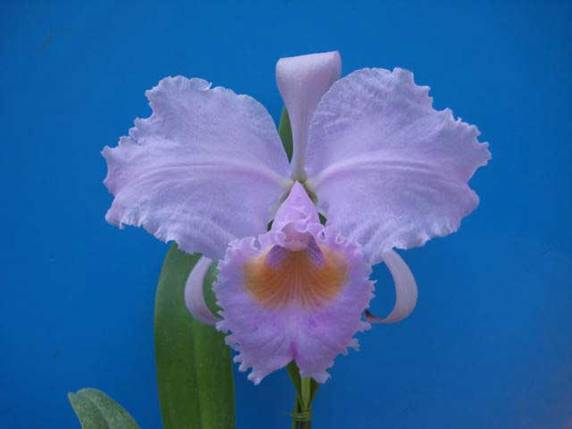
Cattleya schroederae
Rchb.f. (1887)
C. warneri (Brazil)
wikip
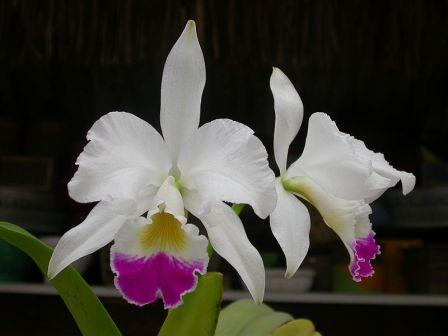
Cattleya warneri
T. Moore ex R. Warner (1862)
C.warneri,amesiana
yamada
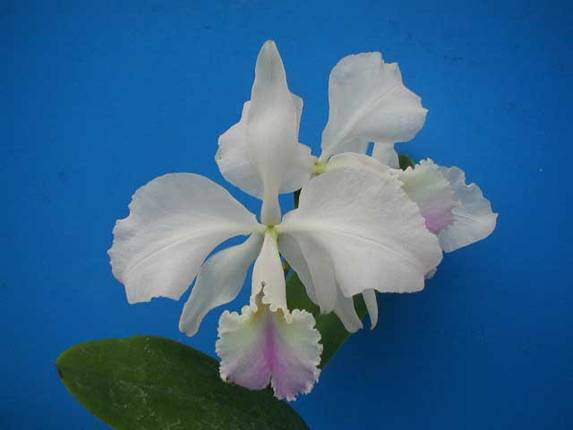
C. mossiae (Venezuela)
wikip
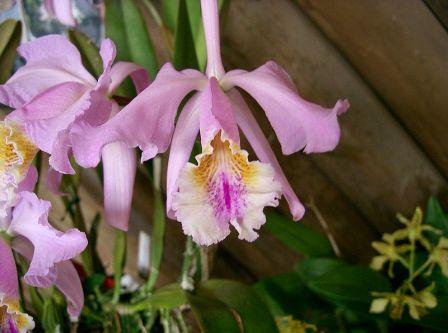
Cattleya mossiae
C.Parker ex Hook. (1838)
C. jenmanii var. alba (Venezuela)
−−−−−−−−−−
C. aurea (Colombia)
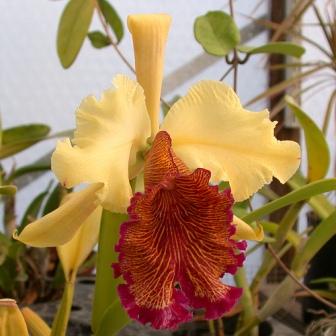
Description: Plant bloom in the summer with 5 to 6 short lived flowers. Flowers are fragrant and 17.5 cm wide. This species is highly endangered in the wild and as such should never be bought unless it is guaranteed to be seed grown
Distribution: Plant is found growing on trees in the states of Risaralda, Antioquia and Choco in Colombia at elevations of 300 to 1000 meters.
Culture: Plants should be grown in medium fir bark with partial to full sun. Cattleya aurea is a intermediate to warm growing orchid species.
Water approximately once a week. Plant can also be mounted.
VaritiesImage Name Description
Cattleya aurea agnes yellow petals and sepals, lip is red with yellow patch
NamingCommon Name: Golden Yellow Cattleya
Retrieved from "http://orchids.wikia.com/wiki/Cattleya_aurea"
C. warcewiczii (Colombia, Brazil) (
=gigas)
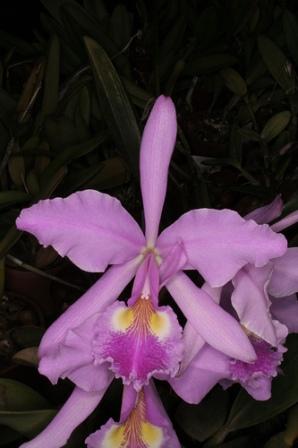
DescriptionPlant blooms in the summer with several 27.5 cm wide flowers.
DistributionPlant is found growing in Colombia at elevations of 500 to 1500 meters
CulturePlants should be grown in medium fir bark with partial to full sun. The plant is a cool to warm growing orchid species. Water approximately once a week. Plant can also be mounted.
NamingCommon Name:Warscewicz's Cattleya
Retrieved from "http://orchids.wikia.com/wiki/Cattleya_warscewiczii"
C. warcewiczii var. semialba (Colombia, Brazil)
C. warcewiczii var. alba (Colombia, Brazil)
−−−−−maxima節−−−−−
maxima
wikip
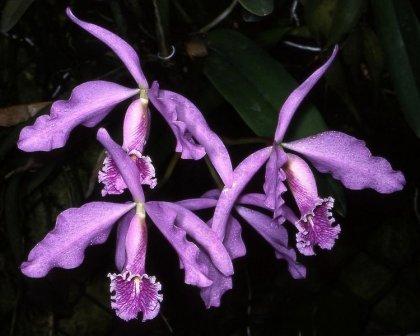
Cattleya maxima
Lindl. (1833)
Synonyms
Epidendrum maximum (Lindl.) Rchb.f. (1861)
suavissima 'Tokyo' x concolor 'Sir Tubota'
yamada
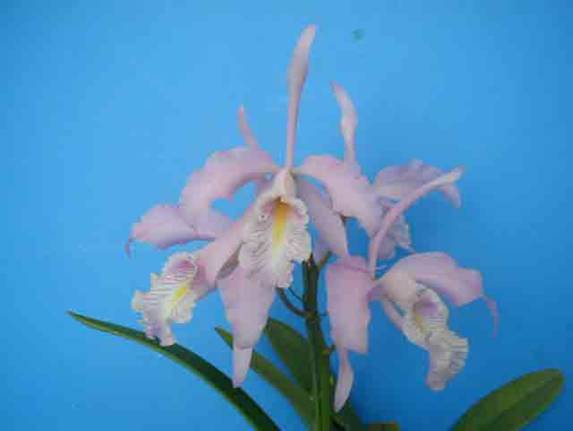
−−−−−Stellata亜属−−−−−
、花径小さい、側花弁幅狭い、唇弁特異
C. luteora (Brazil, Peru, Equador, Bolivia)
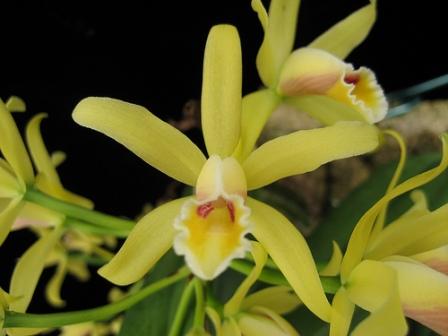
DescriptionPlant blooms from summer to fall with up to ten 5 cm wide flowers. Flowers are fragrant.
DistributionPlant is found growing in the tropical forest of Brazil, Peru, Ecuador and Bolivia at elevations of 100 to 2000 meters
CulturePlants should be grown in medium fir bark with partial to full sun. The plant is a cool to warm growing orchid species. Water approximately once a week. Reduce watering during the winter. Plant can also be mounted.
NamingCommon Name: Pale Yellow Cattleya
Retrieved from "http://orchids.wikia.com/wiki/Cattleya_luteola"
C. iricolor
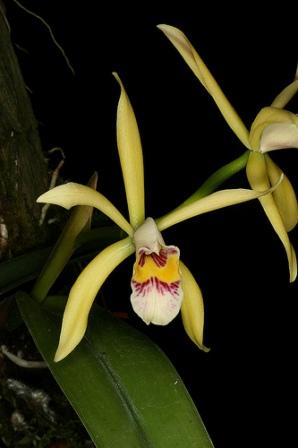
DescriptionPlant blooms from winter to spring with six to ten 8 cm wide flowers.
DistributionPlant is found growing on branches in the montane forest of Peru and Ecuador at elevations of 400 to 1220 meters.
CulturePlants should be grown in medium fir bark with partial to full sun. The plant is a warm growing orchid species. Water approximately once a week. Plant can also be mounted.
NamingCommon Name: Rainbow-colored Cattleya
Retrieved from "http://orchids.wikia.com/wiki/Cattleya_iricolor"
aragualensis
mooreana
wikip-
yamada
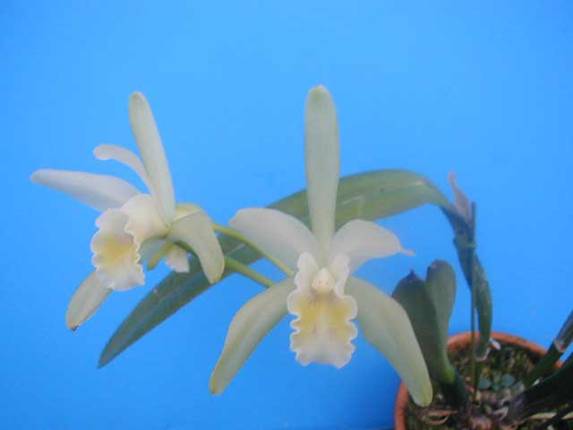
−−−−−−−−−−Rhizanthemum亜属−−−−−−−−−−
、花を葉の退化したシュートに付ける
C. walkeriana(Brazil)
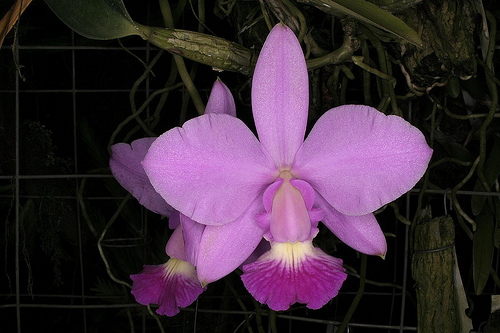
DescriptionPlant blooms from late winter to summer with one to two 12 cm wide flowers. Flowers are fragrant.
DistributionPlants are found growing on trees, limestone slopes and moist rocks in Brazil at elevations from 0 to 2000 meters.
CulturePlants should be grown in medium fir bark with partial to full sun. The plant is a intermediate to warm growing orchid species. Water approximately once a week. Plant can also be mounted.
VarietiesImage Name Description
Cattleya walkeriana var alba Sepals and petals are white, lip is white
Cattleya walkeriana var coerulea Sepals and petals are white, lip is purple
Cattleya walkeriana var semi-alba 'Kenny' Sepals and petals are white, lip is cream color with a red patch
Cattleya walkeriana 'Cotia' Sepals and petals are pink, lip is magenta
edit NamingCommon Name:Walker's Cattleya
Retrieved from "http://orchids.wikia.com/wiki/Cattleya_walkeriana"
C. walkeriana var coerulea (Brazil)
C. nobilior (Brazil)
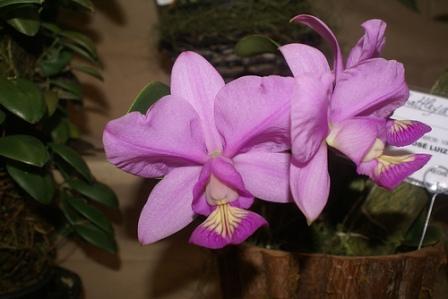
DescriptionPlant blooms during winter through spring with several 8-10 cm wide flowers born from a specialized growth. Flowers are fragrant with the scent of anise.
DistributionPlant is found growing in Matto Grossa State, Brazil and Santa Cruz, Bolivia at elevations of 170 to 700 meters
CulturePlants should be grown in medium fir bark with partial to full sun. The plant is a warm growing orchid species. Water approximately once a week. Plant can also be mounted.
VarietiesImage Name Description
Cattleya nobilior variant white petals and sepals, lip is white with purple veins
NamingCommon Name: Noble Cattleya
C. nobilior var. coerulea (Brazil)
−−−−−−−−−−C. kerrii−−−−−−−−−−
、1-2茎、茎は細い、
C. kerrii (Brazil)
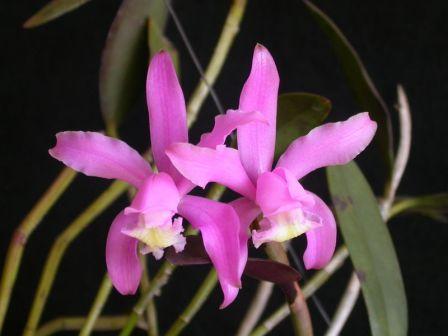
DescriptionPlant blooms in the spring with one to two 8 cm wide flowers.
DistributionPlant is found growing on trees in the swampy forest of
Bahia state of Brazil
CulturePlants should be grown in medium fir bark with moderate to bright light. The plant is a intermediate to warm growing orchid species. Water approximately once a week. Plant can also be mounted.
NamingCommon Name: Kerr's Cattleya
Retrieved from "http://orchids.wikia.com/wiki/Cattleya_kerrii"
−−−−−−−−−−Diphyllae亜属−−−−−−−−−−
、シースは葉身を持たない、
−−−−−Intermedia節−−−−−
C. intermedia (Brazil)

DescriptionPlant flowers from spring to summer with two to seven flowers. Flowers are 12.5 cm wide and fragrant.
DistributionPlant is found growing on rocks and small trees in the
coastal forest of Brazil, Uruguay and Argentina.
CulturePlants should be grown in medium fir bark with partial to full sun. It requires a intermediate to warm temperature. Water approximately once a week. Plant can also be mounted.
VarietiesImage Name Description
Cattleya intermedia var. alba White sepals and petals, with a white lip
Cattleya intermedia var. coerulea White sepals and petals, with a purple lip
Cattleya intermedia var. marginata White sepals and petals, with a magenta lip
Cattleya intermedia var. marginata Pink sepals and petals, with a magenta lip
Cattleya intermedia 'Jerry Elmore' Pink sepals and petals, with a pink lip, HCC/AOS
Cattleya intermedia 'Crownfox' Pink sepals and petals, with a purple lip, HCC/AOS
Image:Cattleya intermedia 'Aranbeen'.jpg White sepals and petals, with a light pink lip, HCC/AOS
Cattleya intermedia var. acquinii Sepals are pink and petals are pink with red patches on the edge, with a red lip
Cattleya intermedia var. acquinii f. coerulea Sepals are white and petals are white with purple patches on the edge, with a purple lip
Cattleya intermedia var. acquinii f. vinicolor Sepals are white and petals are white with red patches on the edge, with a red lip
Cattleya intermedia var. delicata Sepals are pink and petals are pink with magenta patches on the edge, with a magenta lip
edit NamingCommon Name: Intermediate Cattleya
Retrieved from "http://orchids.wikia.com/wiki/Cattleya_intermedia"
C. intermedia var. aquinii (Brazil)
(var. alba)
rang
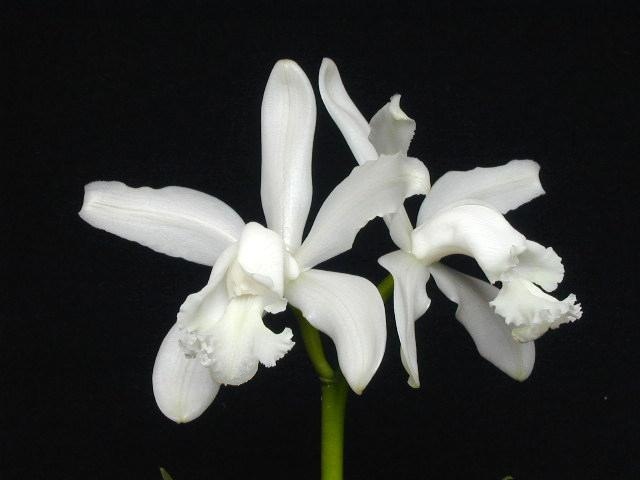 C. harrisoniana
C. harrisoniana (Brazil)
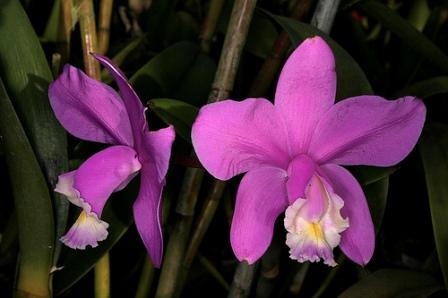
DescriptionPlant blooms in the summer with up to six 11.25 cm wide flowers. Flowers are fragrant.
DistributionPlant is found growing on
rocky cliffs and bushes in humid swampy areas of South eastern Brazil.
CulturePlants should be grown in medium fir bark with partial to full sun. The plant is a intermediate to warm growing orchid species. Water approximately once a week and reduce watering during the winter. Plant can also be mounted.
VaritiesImage Name Description
Cattleya harrisoniana var alba white petals and sepals, lip is white
edit NamingCommon Name:Harrison's Cattleya
Retrieved from "http://orchids.wikia.com/wiki/Cattleya_harrisoniana"
C. forbesii var. alba (Brazil)
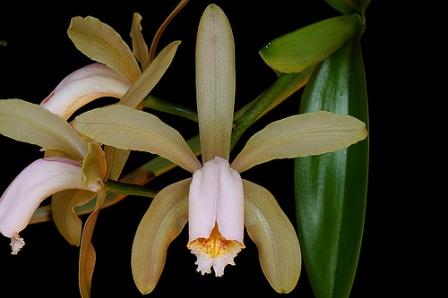
DescriptionPlant blooms from fall to spring with up to six 11 cm wide flowers. Flowers are fragrant.
DistributionPlant is found growing on
trees and rocks in Brazil at elevations of 200 meters
CulturePlants should be grown in medium fir bark with partial to full sun. The plant is a cool to warm growing orchid species. Water approximately once a week. Plant can also be mounted.
NamingCommon Name: Forbes' Cattleya
Retrieved from "http://orchids.wikia.com/wiki/Cattleya_forbesii"
−−−−−Guttata節−−−−−
C. guttata (Brazil)
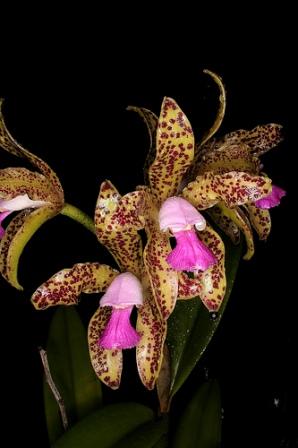
DescriptionPlant blooms from fall to winter with several 10 cm wide flowers.
DistributionPlant is found growing in the
coastal forest of Brazil.
CulturePlants should be grown in medium fir bark with partial bright light. The plant is a cool to warm growing orchid species. Water approximately once a week and reduce watering during the winter. Plant can also be mounted.
VarietiesImage Name Description
Cattleya guttata var. alba Sepals are and petals are green, lip is white
edit NamingCommon Name: Spotted Cattleya
Retrieved from "http://orchids.wikia.com/wiki/Cattleya_guttata"
C. elongata (Brazil)
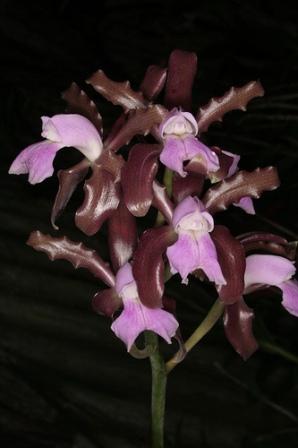
DescriptionPlant blooms from summer to fall with ten 8 cm wide flowers. Flowers are fragrant.
DistributionPlant is found growing on
rock outcrops in Minas Gerais and Pernambuco states of Brazil at elevations of 900 to 1500 meters
CulturePlants should be grown in medium fir bark with partial to full sun. The plant is a cool to warm growing orchid species. Water approximately once a week. Plant can also be mounted.
NamingCommon Name: Cattleya with the Elongated Stalk
Retrieved from "http://orchids.wikia.com/wiki/Cattleya_elongata"
C. leopordii (Brazil)
owiki-, wikip-
C. amethystoglossa (Brazil)
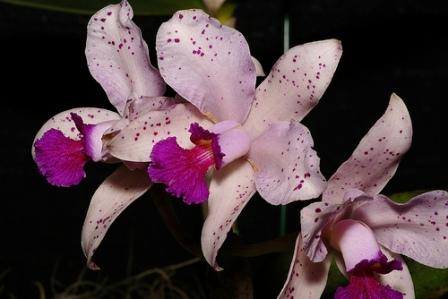
DescriptionPlant bloom from fall through early spring with ten to thirty 10 cm flowers. Flowers are fragrant. The flowers of Cattleya amethystoglossa grow to 4 inches (10 cm) in diameter. Flowers are produced on terminal flower stems that develop at the apex of the pseudobulb. The unbranched inflorescence produces between ten and 30 blooms. Cattleya amethystoglossa is fragrant. The petals and sepals are light lavender to pale rose in color with mauve or magenta spotting. The amount of spotting varies widely between individuals with some individuals demonstrating few spots. The lip is bright magenta in color and partially wraps around the column. The throat varies in color from white to pale yellow or gold.
Cattleya amethystoglossa is a tall plant and has pseudobulbs that grow to
3 feet (1 meter) tall. Each pseudobulb has two (occasionally three) leathery, green leaves at the top. This species is in the Bifoliate division of Cattleyas.
DistributionPlant is found growing in palm tree trunks, rock outcrops, and large tree branches high in the canopy of
evergreen trees trees in Bahia, Minas Gerais and Pernambuco states of Brazil at elevations around 600 meters. This plant is found growing in bright, airy, humid locations. Its native range has been greatly reduced due to habitat destruction, logging, and agriculture.
CulturePlants should be grown in medium fir bark with partial to full sun. The plant is a cool to warm growing orchid species. Water approximately once a week and reduce watering during the winter. Plant can also be mounted.
VaritiesImage Name Description
Cattleya amethystoglossa var coerulea white petals and sepals, lip is purple
Cattleya amethystoglossa "Jimmy Rogers" Spotted pink petals and sepals, lip is magenta
NamingCommon Name: Amethest Lipped Cattleya
−−−−−Intermedia節−−−−−
C. loddigesii (Brazil, Argentina)

DescriptionPlant blooms in the late summer
C. x dolosa (= C. loddigesii × C. walkeriana) (Brazil)
coerulea
yamada
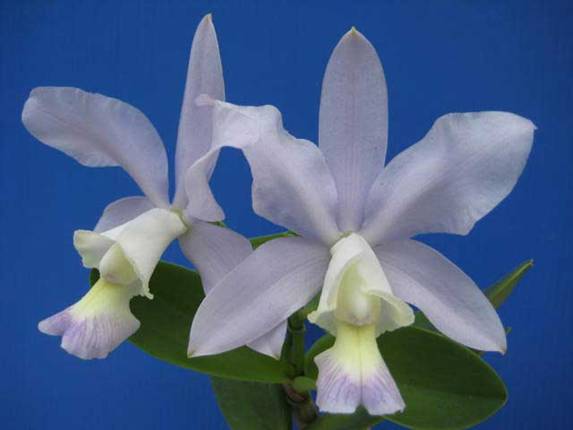
C. x dolosa var. alba (Brazil)
−−−−−Acranthemum節−−−−−
C. aclandiae (Brazil)
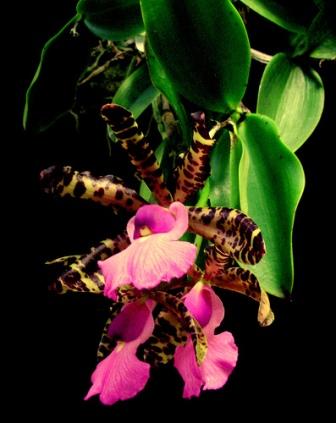
DescriptionPlant blooms from summer to fall with several 10 cm wide flowers. Flowers are fragrant. Flowers are substantial, waxy, and long-lived. Flower color is white or near-white with purple blotches and spots. The lip has a dark purple blotch and the anther cap is yellow.
There are coerulea forms available in the orchid trade. Cattleya aclandiae has been widely used by orchid breeders to produce compact hybrids. When crossed with other bifoliate cattleyas, the spotted pattern is present in the offspring. Hybrids of this species generally produce plants that flower two or more times per year.
Cattleya aclandiae is compact and only grows 3-5 in. (7-12 cm) tall. The upright, short, cylindrical pseudobulbs have two fleshy leaves at the apex. Sometimes, purple blotches are found on the leaves when the plants are exposed to intense sunlight. Each growth produces between one and three 2.5 inches to 4 inches (6 to 10 cm) and the flowers are large for the size of the plant.
DistributionThis species is found growing on
tree limbs and trunks in the Brazilian state of Bahia Cattleya aclandiae has a very small natural range and is found growing in the wind southwest of Salvador on elevated plateaus that border the drainage of the Paraguaca River. Its native habitat is seasonally dry coastal forests between 100 and 400 meters in elevation near permanent bodies of water.
CulturePlants should be grown in medium fir bark with partial to full sun. Cattleya aclandiae is a intermediate to warm growing orchid species. Water approximately once a week. Plant can also be mounted.
NamingCommon Name: Lady Ackland's Cattleya
This species was named in honor of Sir Thomas Ackland who was the first European to grow the plant successfully.
C. bicolor (Brazil)
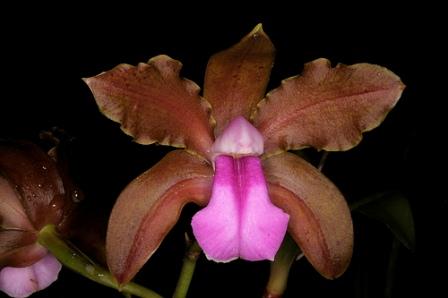
DescriptionPlant blooms at any season with up to seven highly fragrant 10 cm wide flowers.
DistributionPlant is found growing on trees in the
jungles of Brazil.
CulturePlants should be grown in medium fir bark with partial to full sun. The plant is a cool to warm growing orchid species. Water approximately once a week. Plant can also be mounted.
VaritiesImage Name Description
Cattleya bicolor agnes Green petals and sepals, lip is magenta
NamingCommon Name: Bicolored Cattleya
Retrieved from "http://orchids.wikia.com/wiki/Cattleya_bicolor"
velutina
−−−−−Guttata節−−−−−
C. porphyroglossa (Brazil)
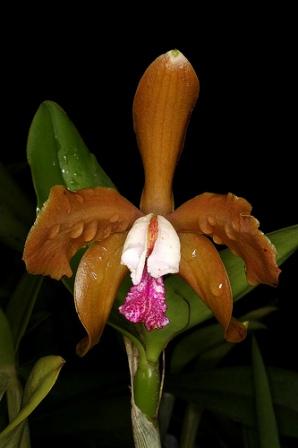
DescriptionPlant bloom in the summer with three to five 7.5 cm wide flowers. Flowers are fragrant.
DistributionPlant is found growing on
trees in Brazil.
CulturePlants should be grown in medium fir bark with partial to full sun. The plant is a intermediate to warm growing orchid species. Water approximately once a week. Plant can also be mounted.
NamingCommon Name: Purple Lipped Cattleya
C. schilleriana (Brazil)
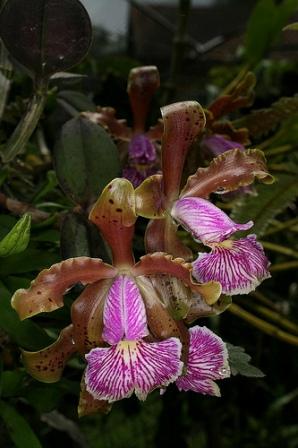
wikip
Cattleya schilleriana
Rchb.f. (1857)
C. violacea (Guyana-Peru, Venezuela,Brazil, Equador)
wikip
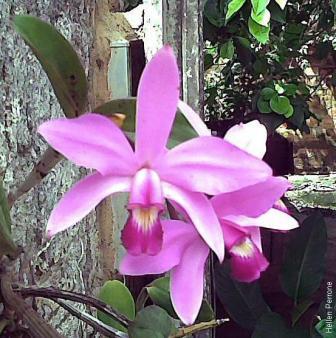 yamada
yamada
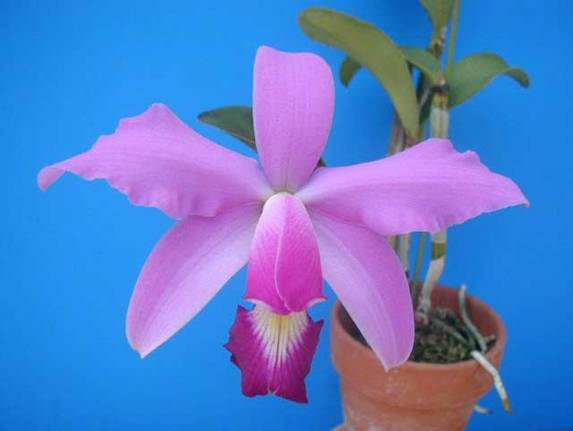
wikip
Cattleya violacea
(Kunth) Rolfe (1889)
−−−−−−−−−−Skinneri亜属−−−−−−−−−−
、多輪
−−−−−Skinnneri節−−−−−
C. skinneri (Guatemala - Panama)
wikip
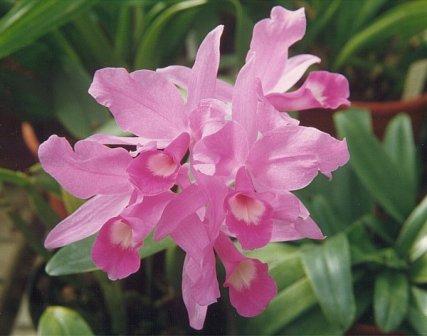 Guarianthe skinneri
Guarianthe skinneri
(Bateman) Dressler & W. E. Higgins
C. x guatemalensis (skinneri x aurantiaca?) (Guatemala)
owik-i, wikip-
−−−−−Aurantiaca節−−−−−
C. aurantiaca (Mexico, Guatemara, El Salvador, Honduras)
wikip
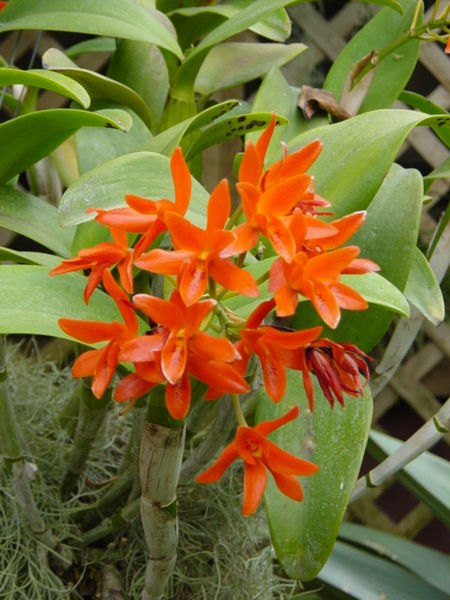 Guarianthe aurantiaca
(Bateman ex Lindl.) Dressler & W.E. Higgins
Guarianthe aurantiaca
(Bateman ex Lindl.) Dressler & W.E. Higgins
−−−−−Moradae節−−−−−
C. bowringiana
wikip
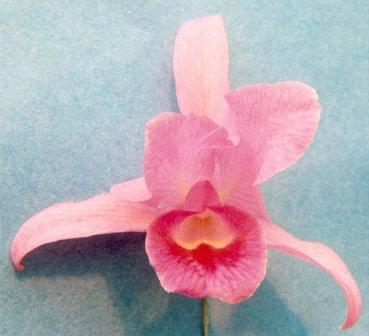 var coerulea (Guatemara, Belize)
C. decker
var coerulea (Guatemara, Belize)
C. decker (Guatemala - Panama, Colombia, Venezuela, Trinidad)
owiki-, wikip-
−−−−−−−−−−Species−−−−−−−−−−
Wikipedia
Cattleya aclandiae : Lady Ackland's Cattleya (Brazil)
Cattleya amethystoglossa : Amethyst-lipped Cattleya (Brazil)
Cattleya araguaiensis : Cattleya from Araguaia river (Brazil) == Cattleyella araguaiensis (Pabst) van den Berg & M.W.Chase, see Cattleyella
Cattleya aurantiaca : Orange Cattleya (Mexico to C. America) == Guarianthe aurantiaca, see Guarianthe
Cattleya aurea : Golden-yellow Cattleya (S. Panama to Colombia). Pseudobulb epiphyte
Cattleya bicolor : Bicolored Cattleya (SE. Brazil)
Cattleya bicolor subsp. bicolor (Brazil). Pseudobulb epiphyte
Cattleya bicolor subsp. canastrensis (Brazil) . Pseudobulb epiphyte
Cattleya bicolor subsp. minasgeraiensis (Brazil). Pseudobulb epiphyte
Cattleya bowringiana : Bowring's Cattleya (Mexico to Honduras) == Guarianthe bowringiana, see Guarianthe
Cattleya candida (Colombia).
Cattleya dormaniana : Dorman's Cattleya (Brazil)
Cattleya dowiana : Queen of the Cattleyas, Dow's Cattleya (Costa Rica).
Cattleya elongata : Cattleya with the Elongated Stalk (Brazil)
Cattleya forbesii : Forbes' Cattleya (Brazil)
Cattleya gaskelliana : Gaskell's Cattleya (Colombia to Trinidad).
Cattleya granulosa : Granulose Cattleya (Brazil)
Cattleya guttata : Spotted Cattleya (Brazil).
Cattleya harrisoniana : Harrison's Cattleya (SE. Brazil).
Cattleya intermedia : Intermediate Cattleya (SE. & S. Brazil, Paraguay, Uruguay).
Cattleya intermedia var. orlata
Cattleya iricolor : Rainbow-colored Cattleya (Ecuador to Peru).
Cattleya jenmanii : Jenman's Cattleya (Venezuela to Guyana).
Cattleya kerrii : Kerr's Cattleya (Brazil).
Cattleya labiata : Crimson Cattleya, Ruby-lipped Cattleya, named for the large labellum (Brazil)
Cattleya lawrenceana : named for Sir Trevor Lawrence (Venezuela, Guyana, N. Brazil).
Cattleya loddigesii : named for the Loddiges brothers (SE. Brazil to NE. Argentina).
Cattleya loddigesii subsp. loddigesii (SE. Brazil to NE. Argentina). Pseudobulb epiphyte
Cattleya loddigesii subsp. purpurea (Brazil). Pseudobulb epiphyte
Cattleya lueddemanniana : Lueddemann's Cattleya (N. Venezuela).
Cattleya luteola : named for the pale yellow flowers (N. Brazil, Ecuador to Bolivia).
Cattleya maxima : Christmas Flower, named for the large flowers (Venezuela to Peru).
Cattleya mendelii : named for Mendel (NE. Colombia).
Cattleya mooreana : named for Moore (Peru).
Cattleya mossiae : Easter Orchid, named for Mrs. Moss (N. Venezuela)
Cattleya nobilior : Noble Cattleya (WC. Brazil to Bolivia).
Cattleya patinii : named for Patin (Costa Rica to Venezuela, Trinidad) == Guarianthe patinii, see Guarianthe
Cattleya percivaliana : Christmas orchid, named for Percival (Colombia to W. Venezuela).
Cattleya porphyroglossa : Purple-lipped Cattleya (Brazil).
Cattleya rex : King of the Cattleyas (Colombia to N. Peru).
Cattleya schilleriana : named for Consul Schiller (Brazil).
Cattleya schofieldiana : named for Schofield (Brazil)
Cattleya schroederae : Easter Orchid, named for Baroness Schroder (NE. Colombia).
Cattleya skinneri : Flower of San Sebastian, Skinner's Cattleya (SE. Mexico to C. America) == Guarianthe skinneri, see Guarianthe
Cattleya tenuis : Slender-stemmed Cattleya (NE. Brazil).
Cattleya tigrina (SE. & S. Brazil).
Cattleya trianae : Dr. Triana's Cattleya (Colombia).
Cattleya velutina : Velvety Cattleya (Brazil)
Cattleya violacea : Superba of the Orinoco, Brazil, Guyana, Violet Cattleya (S. Trop. America).
Cattleya walkeriana : Walker's Cattleya (WC. & SE. Brazil).
Cattleya wallisii (N. Brazil).
Cattleya warneri : Warner's Cattleya (E. Brazil).
Cattleya warscewiczii : Warscewicz's Cattleya (Colombia).
In 2008, the genus Sophronitis was merged into Cattleya.[2]
Guarianthe
Guarianthe is a small genus of epiphytic orchids, growing in wet forests in Central America and northern South America. It has been separated from Cattleya based on phylogenetic studies with DNA sequence data (van den Berg et al., 2000)
Species
Guarianthe aurantiaca (Bateman) Dressler & W.E. Higgins
Guarianthe bowringiana (Veitch) Dressler & W.E. Higgins
Guarianthe patinii (Cogn.) Dressler & W.E. Higgins
Guarianthe skinneri (Bateman) Dressler & W.E. Higgins
Natural hybrid
Guarianthe × guatemalensis (T. Moore) W.E. Higgins
[edit] Natural Hybrids
Cattleya × brasiliensi (= C. bicolor × C. harrisoniana) (Brazil) .
Cattleya × brymeriana (= C. violacea × C. wallisii) (N. Brazil).
Cattleya x calimaniorum Chiron & V.P.Castro (NE Brazil)
Cattleya × colnagiana (Brazil).
Cattleya × dayana (= C. forbesii × C. guttata) (Brazil).
Cattleya × dolosa (= C. loddigesii × C. walkeriana): Dolose Cattleya, Crafty Cattleya, Deceitful Cattleya (Brazil).
Cattleya × dukeana (C. bicolor × C. guttata) (SE. Brazil).
Cattleya × duveenii ( = C. guttata × C. harrisoniana) (SE. Brazil).
Cattleya × gransabanensis (= C. jenmanii × C. lawrenceana) (Venezuela).
Cattleya × guatemalensis (= C. aurantiaca × C. skinneri.) : Guatemalan Cattleya (SE. Mexico to C. America); see Guarianthe
Cattleya × hardyana ( = C. dowiana var.aurea × C. warscewiczii): Hardy's Cattleya (Colombia).
Cattleya × hybrida (= C. guttata × C. loddigesii) (SE. Brazil).
Cattleya × imperator ( = C. granulata × C. labiata) (NE. Brazil).
Cattleya × intricata (=. C. intermedia × C. leopoldii) (S. Brazil).
Cattleya × isabella (.= C. forbesii × C. intermedia) (SE. Brazil).
Cattleya × itatiayae (SE. Brazil).
Cattleya × joaquiniana ( = C. bicolor × C. walkeriana) (Brazil) .
Cattleya × kautskyi (= C. harrisoniana × C.) (SE. Brazil).
Cattleya × lucieniana ( = C. forbesii × C. granulosa) (SE. Brazil).
Cattleya × measuresii ( = C. aclandiae × C. walkeriana) (E. Brazil).
Cattleya × mesquitae ( = C. nobilior × C. walkeriana) (Brazil).
Cattleya × mixta ( = C. guttata × C. schofieldiana) (Brazil).
Cattleya × moduloi (C. schofieldiana × C. warneri) (Brazil).
Cattleya × patrocinii (= C. guttata × C. warneriana): Patrocinio's Cattleya (SE. Brazil).
Cattleya × picturata ( = C. guttata × C. intermedia) (SE. Brazil).
Cattleya × resplendens ( = C. granulosa × C. schilleriana) (NE. Brazil)
Cattleya × scita (= C. intermedia × C. tigrina) (S. Brazil).
Cattleya × tenuata (= C. elongata × C. tenuis) (Brazil) .
Cattleya × undulata ( = C. elongata × C. schilleriana) (Brazil).
Cattleya × venosa (= C. forbesii × C. harrisoniana) (Brazil).
Cattleya × victoria-regina ( C. guttata × C. labiata) (NE. Brazil).
Cattleya × wilsoniana ( = C. bicolor × C. intermedia). (Brazil).
Cattleya x zayrae V.P.Castro & Cath (Bahia, Brazil)






































